Napa, California
Napa, California | |
|---|---|
|
Clockwise: Napa Waterfront; Alexandria Hotel; Darioush Winery; Downtown Napa; Domaine Carneros | |
 Location in Napa County and the state of California | |
| Coordinates: 38°18′17″N 122°17′56″W / 38.30472°N 122.29889°W[1] | |
| Country | United States |
| State | California |
| County | Napa |
| Region | Northern California |
| Incorporated | March 23, 1872[2] |
| Government | |
| • Type | Mayor and Council Government |
| • Mayor | Scott Sedgley (D)[3] |
| Area | |
• City | 18.28 sq mi (47.33 km2) |
| • Land | 17.97 sq mi (46.54 km2) |
| • Water | 0.31 sq mi (0.79 km2) 1.69% |
| Elevation | 20 ft (6 m) |
| Population | |
• City | 79,246 |
• Estimate (2022)[7] | 77,480 |
| • Density | 4,348.1/sq mi (1,678.80/km2) |
| • Metro | 138,019 |
| Time zone | UTC-8 (Pacific (PST)) |
| • Summer (DST) | UTC-7 (PDT) |
| ZIP Codes[8] | 94558, 94559, 94581 |
| Area code | 707 |
| FIPS code | 06-50258 |
| GNIS feature IDs | 277561, 2411209 |
| Website | www |
Napa is the largest city and county seat of Napa County and a principal city of Wine Country in Northern California, United States. Located in the North Bay region of the Bay Area, the city had a population of 77,480 as of the end of 2021.[9] Napa is a major tourist destination in California, known for its wineries, restaurants, and arts culture.
History
[edit]
The origin of the word "Napa" is disputed.
The word "napa" is of Native American derivation and has been variously translated as "grizzly bear", "house", "motherland" or "fish". Of the many explanations of the name's origin, the most plausible seems to be that it is derived from the Patwin word napo, meaning "house".[10]
Further adding confusion, Napa was originally spelled with two Ps: Nappa.[11] There are maps and deeds dating back to the mid-1850s bearing this spelling. Shortly thereafter, the present spelling was adopted; the reasons for this are unclear.
Mexican era
[edit]At the time of the first recorded exploration into Napa Valley in 1823, the majority of the inhabitants consisted of Native Americans. Padre José Altimira, founder of Mission San Francisco Solano in Sonoma, led the expedition. Spanish priests converted some natives; the rest were attacked and dispersed by Mexican soldiers.[12]
The first American settlers began arriving in the area in the 1830s.
Post-Conquest era
[edit]
Prior to the American Conquest of California, Napa Valley was in California's District of Sonoma. At the time, its boundaries also included Lake County to the north. By this time, the indigenous people were either working as field laborers or living in small bands in the hills surrounding the valley. Tensions between the white settlers and Native Americans broke into war in 1850, resulting in soldiers hunting down and massacring all the natives they could find, driving the remainder north toward Clear Lake.[13] By 1870, the Native American population consisted of only a few laborers and servants working for the white settlers.
The City of Napa was founded by Nathan Coombs in 1847.[14] General Mariano Guadalupe Vallejo had paid to survey for a township downriver at Soscol Landing, where riverboats could turn around prior to Napa's founding. Instead, the Napa town site was surveyed on property Coombs had received from Nicolas Higuera, original holder of the Rancho Entre Napa, a Mexican land grant. The first record of a ship navigating the river was the Susana in 1842, though by 1850 the Dolphin became the first passenger steamship to navigate the Napa River in order to open another path of commerce.
In the mid-1850s, Napa's Main Street rivaled that of many larger cities, with as many as 100 saddle horses tied to the fences on an average afternoon. John Patchett opened the first commercial winery in the county in 1859.[15] The Napa Valley Register, founded by J.I. Horrell and L. Hoxie Strong, made its debut on August 10, 1863, with weekly publications until becoming a daily newspaper in 1872.[16]
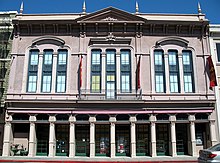
The California Gold Rush of the late 1850s expanded Napa City. A tent city was erected along Main Street. Many cattle ranches were maintained, and the lumber industry had greatly expanded. Sawmills in the valley were in operation cutting up timber that was hauled by team to Napa and then shipped out on the river to Benicia and San Francisco.

In 1858, the great silver rush began in Napa Valley, and miners eagerly flocked to the eastern hills. In the 1860s, mining carried on, in a large scale, with quicksilver mines operating in many areas of Napa County. The most noted mine was the Silverado Mine, near the summit of Mount Saint Helena. At this time, the first wave of rural, foreign laborers from coastal villages of China's Canton province arrived in California and at Napa County mines. A settlement for Chinese laborers in Napa was established in the early 1860s. At its peak from the 1880s to the early 1900s, the Chinese population grew to a population of over 300 people.[18]
In 1869, F. A. Sawyer established Sawyer Tanning Company in Napa and was joined in the business by his father B. F. Sawyer a year later. It went on to become the largest tannery west of the Mississippi River. The world-famous Nappa leather or Napa leather was invented by Emanuel Manasse in Napa in 1875 while working at the Sawyer Tanning Company.
Napa was incorporated on March 23, 1872, and reincorporated in 1874 as the City of Napa.
The Napa State Hospital received its first patients in 1876. The Napa Valley Opera House became popular after its debut on February 13, 1880, with a production of Gilbert and Sullivan's HMS Pinafore, but it later languished and was closed for many years.[19] It was reestablished in the 1980s.
Modern era
[edit]
Napa had become the primary business and economic center for the Napa Valley by the dawn of the 20th century. The San Francisco, Napa and Calistoga Railway was established in 1905 for passenger and freight service. The railroad carried passengers from ferry boats in Vallejo to stops in Napa and other locations in the valley.[20][21]
As agricultural and wine interests developed north of the city limits, much of the light industry, banking, commercial and retail activity in the county evolved within the city of Napa and in earlier times along the Napa River through the historic downtown. Napa Glove Factory was established in 1903 and was the largest plant of its kind west of Chicago.
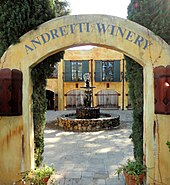
Edwin Pridham and Peter L. Jensen invented the moving-coil loudspeaker in 1915 in their Napa workshop while working on an improvement for the telephone receiver. Pridham and Jensen went on to found the Magnavox Company in 1917.[22] In the late 19th century and early 20th century, Napa was known for having a sizable red-light district, with brothels primarily concentrated on and around Clinton Street.[23]
Following studies made by the U.S. Department of the Interior in 1930-40s, the U.S. Congress authorized channel improvements on Napa River and construction of a dam on Conn Creek as part of the Flood Control Act of 1944, though funding was never approved. The City of Napa funded and built the dam in order to create the water conservation reservoir Lake Hennessey in 1948; however, flooding continued to be a problem.

The 1986 Napa River flood revived public interest in finding a remedy. After a plan to widen the river channel proposed by the Army Corps of Engineers was presented in 1995 and roundly rejected, a group of special interests called Friends of the River formed, which built consensus on a "living river" plan. Voters in the County of Napa narrowly approved an increase of sales tax in a March 1998 election to fund the Napa River Flood Project.[24] In 2005, the Napa River again flooded the entire downtown area and destroyed 1,000 homes across the county.[25]
An ambitious redevelopment plan encompassing several blocks of downtown Napa's retail property was undertaken by the city in the early 1970s, though it did little to improve the city's economy. Downtown Napa finally began to recover and emerge from a long economic slumber in the 2000s, triggered by a significant growth in Main Street restaurants and hotels. The redevelopment of First and Main streets and the Napa Mill complex helped to stimulate investments along the Napa riverfront.
In 2014, the Napa area was struck by a magnitude 6.1 earthquake centered 3.7 miles (6.0 km) northwest of nearby American Canyon.[26][27][28][29] In October 2017, the Atlas Fire and Partrick Fires burned several parts of Napa County (see also October 2017 Northern California wildfires).
Geography
[edit]According to the United States Census Bureau, the city has a total area of 18.1 square miles (47 km2), of which 17.8 square miles (46 km2) is land and 0.3 square miles (0.78 km2), or 1.69%, is water. Napa was the first location in California to be part of the North Coast American Viticultural Area.[30] Renowned for its wine due to the Mediterranean climate, surprisingly only about 9% of Napa's acreage is planted with grapes.[31]
The Napa River traverses the city on its journey to the San Pablo Bay. The city has conducted a variety of waterfront development along the banks of the river, including certain fill operations governed by the United States Army Corps of Engineers regulations.[32] The Napa River Flood Project has been in progress since the late 1990s, with the goal of mitigating the risk of flooding along a 6-mile (9.7 km) stretch of the river and 1-mile (1.6 km) of Napa Creek.
Climate
[edit]Napa has a Mediterranean climate similar to many other parts of Northern California. Winters are cool and damp and summers are warm and dry. During the summer months rain is rare. Occasionally there may be a day or two of light rain in June and September. Heat waves do occur, with the temperatures rising above 100 °F (38 °C). Wildfires can be a problem during the summer months. The fall is pleasant and many people come to visit Napa at this time. The winters are quite wet and cool and flooding can be a problem. Nighttime temperatures occasionally drop below freezing (32 °F or 0 °C). The rainy season is from October to April and occasionally into May. Snow is rare. The hottest temperature recorded in Napa was 114 °F (46 °C) on September 6, 2022, while the coldest temperature recorded was 14 °F (−10 °C) on December 22, 1990. The most rainfall in one year was 51.24 inches (1,301 mm) in 1983 and the least amount of rainfall was 6.74 inches (171 mm) in 2013. The most rainfall in one month was 16.13 inches (410 mm) in December 1955.[33]
| Climate data for Napa, California (Napa County Airport), 1991–2020 normals, extremes 1893–present | |||||||||||||
|---|---|---|---|---|---|---|---|---|---|---|---|---|---|
| Month | Jan | Feb | Mar | Apr | May | Jun | Jul | Aug | Sep | Oct | Nov | Dec | Year |
| Record high °F (°C) | 85 (29) |
86 (30) |
92 (33) |
95 (35) |
104 (40) |
113 (45) |
110 (43) |
110 (43) |
114 (46) |
106 (41) |
90 (32) |
81 (27) |
114 (46) |
| Mean maximum °F (°C) | 67.1 (19.5) |
73.4 (23.0) |
79.0 (26.1) |
86.7 (30.4) |
91.6 (33.1) |
98.3 (36.8) |
98.2 (36.8) |
98.1 (36.7) |
98.2 (36.8) |
91.4 (33.0) |
78.2 (25.7) |
66.9 (19.4) |
102.5 (39.2) |
| Mean daily maximum °F (°C) | 56.9 (13.8) |
60.9 (16.1) |
64.2 (17.9) |
68.1 (20.1) |
73.1 (22.8) |
78.3 (25.7) |
78.7 (25.9) |
80.0 (26.7) |
80.3 (26.8) |
75.4 (24.1) |
65.1 (18.4) |
57.3 (14.1) |
69.9 (21.0) |
| Daily mean °F (°C) | 47.6 (8.7) |
50.4 (10.2) |
53.0 (11.7) |
55.8 (13.2) |
60.5 (15.8) |
65.1 (18.4) |
66.7 (19.3) |
67.2 (19.6) |
65.7 (18.7) |
60.6 (15.9) |
52.7 (11.5) |
47.5 (8.6) |
57.7 (14.3) |
| Mean daily minimum °F (°C) | 38.2 (3.4) |
40.0 (4.4) |
41.7 (5.4) |
43.5 (6.4) |
47.8 (8.8) |
51.8 (11.0) |
54.8 (12.7) |
54.4 (12.4) |
51.0 (10.6) |
45.9 (7.7) |
40.4 (4.7) |
37.6 (3.1) |
45.6 (7.6) |
| Mean minimum °F (°C) | 29.5 (−1.4) |
32.4 (0.2) |
34.3 (1.3) |
36.8 (2.7) |
41.9 (5.5) |
46.5 (8.1) |
50.3 (10.2) |
49.8 (9.9) |
46.1 (7.8) |
40.3 (4.6) |
33.3 (0.7) |
29.1 (−1.6) |
27.4 (−2.6) |
| Record low °F (°C) | 19 (−7) |
23 (−5) |
23 (−5) |
27 (−3) |
30 (−1) |
34 (1) |
38 (3) |
37 (3) |
36 (2) |
28 (−2) |
25 (−4) |
14 (−10) |
14 (−10) |
| Average precipitation inches (mm) | 5.12 (130) |
5.53 (140) |
3.91 (99) |
1.89 (48) |
1.02 (26) |
0.22 (5.6) |
0.01 (0.25) |
0.02 (0.51) |
0.27 (6.9) |
1.55 (39) |
3.49 (89) |
5.23 (133) |
28.26 (718) |
| Average precipitation days (≥ 0.01 in) | 9.9 | 9.8 | 9.6 | 5.9 | 3.2 | 1.0 | 0.1 | 0.2 | 1.0 | 3.2 | 7.2 | 10.3 | 61.4 |
| Source 1: NOAA[34] | |||||||||||||
| Source 2: National Weather Service[33] | |||||||||||||
Demographics
[edit]| Census | Pop. | Note | %± |
|---|---|---|---|
| 1850 | 159 | — | |
| 1870 | 1,879 | — | |
| 1880 | 3,731 | 98.6% | |
| 1890 | 4,395 | 17.8% | |
| 1900 | 4,036 | −8.2% | |
| 1910 | 5,791 | 43.5% | |
| 1920 | 6,757 | 16.7% | |
| 1930 | 6,437 | −4.7% | |
| 1940 | 7,740 | 20.2% | |
| 1950 | 13,579 | 75.4% | |
| 1960 | 22,170 | 63.3% | |
| 1970 | 36,103 | 62.8% | |
| 1980 | 50,879 | 40.9% | |
| 1990 | 61,842 | 21.5% | |
| 2000 | 72,585 | 17.4% | |
| 2010 | 76,915 | 6.0% | |
| 2020 | 79,246 | 3.0% | |
| 2023 (est.) | 76,821 | [35] | −3.1% |
| U.S. Decennial Census[36] | |||
2010
[edit]
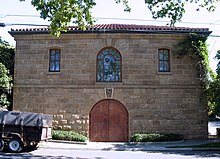
The 2010 United States Census[37] reported that Napa had a population of 76,915. The population density was 4,238.5 inhabitants per square mile (1,636.5/km2). The racial makeup of Napa was 57,754 (75.1%) White, 486 (0.6%) African American, 637 (0.8%) Native American, 1,755 (2.3%) Asian, 144 (0.2%) Pacific Islander, 13,256 (17.2%) from other races, and 2,883 (3.7%) from two or more races. Hispanic or Latino of any race were 28,923 persons (37.6%).
The Census reported that 75,678 people (98.4% of the population) lived in households, 568 (0.7%) lived in non-institutionalized group quarters, and 669 (0.9%) were institutionalized.
There were 28,166 households, out of which 9,826 (34.9%) had children under the age of 18 living in them, 13,862 (49.2%) were opposite-sex married couples living together, 3,201 (11.4%) had a female householder with no husband present, 1,571 (5.6%) had a male householder with no wife present. There were 1,694 (6.0%) unmarried opposite-sex partnerships, and 221 (0.8%) same-sex married couples or partnerships. 7,457 households (26.5%) were made up of individuals, and 3,278 (11.6%) had someone living alone who was 65 years of age or older. The average household size was 2.69. There were 18,634 families (66.2% of all households); the average family size was 3.25.
The population was spread out, with 18,848 people (24.5%) under the age of 18, 6,724 people (8.7%) aged 18 to 24, 20,933 people (27.2%) aged 25 to 44, 19,919 people (25.9%) aged 45 to 64, and 10,491 people (13.6%) who were 65 years of age or older. The median age was 37.4 years. For every 100 females, there were 97.4 males. For every 100 females age 18 and over, there were 94.8 males.
There were 30,149 housing units at an average density of 1,661.4 units per square mile (641.5 units/km2), of which 16,148 (57.3%) were owner-occupied, and 12,018 (42.7%) were occupied by renters. The homeowner vacancy rate was 2.3%; the rental vacancy rate was 5.7%. 41,591 people (54.1% of the population) lived in owner-occupied housing units and 34,087 people (44.3%) lived in rental housing units.
Economy
[edit]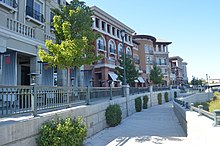
Napa's economy is characterized by its position as one of the principal cities of Wine Country, resulting in a significant portion of jobs in the city relating to wineries, restaurants, hotels, and other hospitality industries.
The Napa State Hospital is located in Imola, an unincorporated area bordering the city of Napa.
The Napa Valley Business Park is located adjacent to the Napa County Airport in an unincorporated area of Napa County. Employers in the area include The Doctors Company and Treasury Wine Estates.
- Top employers
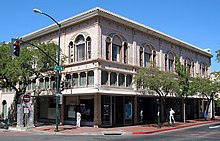
The town's comprehensive annual financial report for the fiscal year that ended June 30, 2020, lists the top ten employers in the City of Napa as the following:[38]
| No. | Top Employers | Employees |
|---|---|---|
| 1 | Napa Valley Unified School District | 1,735 |
| 2 | County of Napa | 1,209 |
| 3 | City of Napa | 434 |
| 4 | Walmart | 300 |
| 5 | Napa Valley College | 290 |
| 6 | Kaiser Permanente | 262 |
| 7 | The Meadows of Napa Valley Assisted Living | 193 |
| 8 | Napa Valley Wine Train | 193 |
| 9 | The Westin Verasa Napa | 168 |
| 10 | Napa Valley Marriott Hotel & Spa | 164 |
Government
[edit]
In the California State Legislature, Napa is in the 3rd Senate District, represented by Democrat Bill Dodd,[39] and in the 4th Assembly District, represented by Democrat Cecilia Aguiar-Curry.[40] In the United States House of Representatives, Napa is in California's 4th congressional district, represented by Democrat Mike Thompson.[41]
Transportation
[edit]
CA-29 runs through Napa, connecting to Vallejo and the East Bay Area to the south and the Napa Wine Country to the north. CA-12 runs to the south of the city, connecting to Fairfield and Interstate 80 to the east and Sonoma and US-101 to the west.
Napa is also served by several airports: Oakland and San Francisco International 50 miles (80 km) to the south, Sonoma County 30 miles (48 km) northwest, and Sacramento International Airport 65 miles (105 km) northeast. Napa County Airport to the south, also serves as a small public airport.
Valley Intercity Neighborhood Express,[42] more commonly known by the acronym "VINE Transit", is the public transportation service for Napa as well as for Napa County. It is managed under the Napa County Transportation and Planning Agency and is operated by Veolia Transportation. VINE has additional service throughout the county and has connections to other public transportation systems in the nearby counties.
The Amtrak Thruway 7 bus makes daily stops in Napa to/from the Soscol Gateway Transit Center at 825 Burnell Street. From there, connections are available to Martinez to the south, and Arcata to the north.[43]
Evans Transportation provides daily service to and from Oakland International Airport and San Francisco International Airport daily from their main office on CA-29.[44]
Notable people
[edit]This section needs additional citations for verification. (September 2018) |
- Larry Allen, former NFL player
- Alisa Bellettini, television producer, creator of House of Style[45]
- Jerry Bohlander, mixed martial arts fighter
- Phil Bonifield, NASCAR driver
- John Boyett, former NFL player
- Warren Brusstar, MLB player
- Bill Buckner, MLB player
- Cristina García, novelist
- Mike Gibson, NFL player for the Arizona Cardinals
- Bill Green, former U.S. and NCAA record holder in Track and Field, 5th place in the hammer throw at the 1984 Olympic Games[46]
- Steve Hendrickson, former NFL player
- Adam Housley, Fox News correspondent
- Josh Jackson, NBA player
- Joe Kmak, MLB player for the Milwaukee Brewers and Chicago Cubs
- Jim Landis, MLB player
- Ray Manzarek, The Doors keyboard player[47]
- Scott McCarron, Professional Golfer
- Peter Menzel, photographer
- Johnny Miller, golfer
- Olivia O'Brien, musician [48]
- Donny Robinson, Olympic BMX bronze medalist
- Andrew Talansky, Professional Cyclist for Cannondale-Garmin
- Shirley Walker, film score composer
- Charles Woodson, former NFL player and Heisman Trophy winner.
Sister cities
[edit]Napa's sister cities are:[49]
 Casablanca, Chile
Casablanca, Chile Iwanuma, Japan, since February 15, 1973
Iwanuma, Japan, since February 15, 1973 Launceston, Australia
Launceston, Australia
See also
[edit]- List of cities and towns in California
- List of cities and towns in the San Francisco Bay Area
- Napa Valley AVA
- Napa Valley Register
- Wine Country
References
[edit]- ^ "US Gazetteer files: 2010, 2000, and 1990". United States Census Bureau. February 12, 2011. Retrieved April 23, 2011.
- ^ "California Cities by Incorporation Date". California Association of Local Agency Formation Commissions. Archived from the original (Word) on October 17, 2013. Retrieved August 25, 2014.
- ^ "City Council". City of Napa. Archived from the original on November 6, 2014. Retrieved August 25, 2014.
- ^ "2019 U.S. Gazetteer Files". United States Census Bureau. Retrieved July 1, 2020.
- ^ "Napa". Geographic Names Information System. United States Geological Survey, United States Department of the Interior.
- ^ "Napa (city) QuickFacts". United States Census Bureau. Archived from the original on July 12, 2006. Retrieved May 13, 2015.
- ^ "Napa County's Population Continues to Shrink". Napa Valley Register. May 8, 2022. Retrieved May 13, 2022.
- ^ "ZIP Code(tm) Lookup". United States Postal Service. Retrieved November 23, 2014.
- ^ "Napa County's population continues to shrink". May 8, 2022.
- ^ "California State Association of Counties". California State Association of Counties.
- ^ Brown, Alexandria (May 28, 2014). "Napa or Nappa?". Napa County Historical Society. Retrieved October 8, 2023.
- ^ Heidenreich, Linda (2007). This Land Was Mexican Once: Histories of Resistance from Northern California. University of Texas Press. p. 5. ISBN 978-0292779389.
- ^ "Angwin: Then and Now". Angwin Community Council. Archived from the original on August 19, 2013. Retrieved March 23, 2013.
- ^ Napa County Historical Society website
- ^ Brennan, Nancy (November 21, 2010). "John Patchett: Introducing one of Napa's pioneers". Napa Valley Register. Retrieved September 30, 2011.
- ^ Peter Jensen (August 10, 2013). "Napa Valley Register turns 150". Napa Valley Register. Napa Valley Publishing.
- ^ "National Register #73000414: Napa Opera House in Napa, California". noehill.com. Retrieved November 29, 2022.
- ^ Yerger, Rebecca (June 21, 2014). "Flood bypass eradicates last vestige of Napa's Chinatown". Napa Valley Register. Retrieved July 8, 2014.
- ^ "The early Opera House". Napa Valley Register. October 24, 2010. Retrieved October 24, 2010.
- ^ Courtney, Kevin (December 20, 2009). "Hidden history in Napa". Napa Valley Register. Retrieved February 11, 2013.
- ^ Brennan, Nancy (April 11, 2010). "Shock of the new: Harry Ayres and Napa's electric railway". Napa Valley Register. Retrieved February 11, 2013.
- ^ Todorov, Kerana (May 10, 2015). "Inventors of loudspeaker honored in Napa". Napa Valley Register. Retrieved May 10, 2015.
- ^ Pogue, Lindsey (March 3, 2010). "Bawdy babes and brothels in Napa's infamous red light-district". Napa Valley Register. Retrieved March 21, 2010.
- ^ "The History of Floods and the Creation of a New Project". Archived from the original on May 5, 2011. Retrieved January 18, 2019.
- ^ Kevin Courtney (2005). "Severe flooding hits the Napa Valley". Napa Valley Register. Retrieved December 31, 2005.
- ^ "Earthquake rocks northern California". BBC Online. August 24, 2014. Retrieved August 24, 2014.
- ^ Lee, Henry K.; Kane, Will; Espinosa Solis, Suzanne; Ho, Vivian (August 24, 2014). "Napa damaged, more than 100 hurt in Northern California quake". San Francisco Chronicle. Retrieved August 24, 2014.
- ^ "M6.0 - 6km NW of American Canyon, California". USGS. August 24, 2014. Retrieved August 24, 2014.
- ^ Global Earthquake Epicenters. "Map of the earthquake M6.0 - 6km NW of American Canyon, California 2014-08-24 10:20:44 UTC". Geographic.org. Retrieved September 28, 2014.
- ^ "Napa Valley American Viticultural Area". Napa Vintners.
- ^ "Napa Vinters". Napa Vintners.
- ^ Section 404 (b) 1 Alternatives Analysis Pursuant to 40 CFR 230.10 for the Safeway Longs Center, Napa, Ca., Earth Metrics Inc., U.S. Army Corps of Engineers Document, August 1989
- ^ a b "NOAA Online Weather Data". National Weather Service. Retrieved September 7, 2022.
- ^ "U.S. Climate Normals Quick Access". National Oceanic and Atmospheric Administration. Retrieved September 7, 2022.
- ^ "STATE'S POPULATION DECLINE SLOWS WHILE HOUSING GROWS PER NEW STATE DEMOGRAPHIC REPORT" (PDF). Retrieved January 17, 2024.
- ^ "Census of Population and Housing". Census.gov. Retrieved June 4, 2015.
- ^ "2010 Census Interactive Population Search: CA - Napa city". U.S. Census Bureau. Archived from the original on July 15, 2014. Retrieved July 12, 2014.
- ^ City of Napa, California: Comprehensive Annual Financial Report for the Fiscal Year Ended June 30, 2020, p. 151.
- ^ "Senators". State of California. Retrieved August 25, 2014.
- ^ "Members Assembly". State of California. Retrieved August 25, 2014.
- ^ "California's 4th Congressional District - Representatives & District Map". Civic Impulse, LLC. Retrieved September 8, 2023.
- ^ Motor Bus Society, Convention Report, Spring 2005. April 18, 2005
- ^ "Route 7".
- ^ "Evans Transportation Website".
- ^ Rosenberg, Eli (February 24, 2016). "Alisa Bellettini, Creator of MTV's 'House of Style,' Dies at 61". New York Times. Retrieved March 13, 2016.
- ^ "The 1984 U.S. Olympic track and field team, chosen..." UPI Archive. June 25, 1984. Retrieved October 27, 2017.
- ^ "Ray Manzarek, founding Doors member and Napa resident, dies". napavalleyregister.com. May 20, 2013. Retrieved July 7, 2016.
- ^ "olivia o'brien". soundcloud.com. Retrieved July 8, 2016.
- ^ "Sister Cities". cityofnapa.org. City of Napa. Retrieved January 14, 2021.








